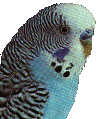skip to main |
skip to sidebar
Budgerigar (Parakeet) Description
Physical Description
The budgie is often refered to as a 'parakeet'. The normal budgie has a bright green plumage on the chest. The wings are a mix of green with black. The heads of the budgie has black lines covering a yellow head. There are several variations to this basic budgerigar, including yellow, blue (cobalt), violet, and albino.
Some budgies have been bred down in size but with a greater number of color mixes. They are generally "aviary bred" in groups, and are referred to as American Budgies. Others have been selectively chosen and bred up, with a more pronounced forehead and larger overall size. These birds are referred to as English Budgies. Both American and English budgies are the same birds, but bred differently for different purposes.
Younger birds have the lines down the forehead of the bird, and the eye is entirely black (except for albinos). As the bird matures the lines receed on the forehead, and a white ring forms around the 'pupil' of the eye.
Length
7 inch - parakeet. 10 inch - English Budgie.
Ave. Lifespan
Sexing
Female birds have a brownish cere. The males have a deep blue cere. The color only appears after the bird is about 6 months old.
Origin:
Australia. The name 'Budgerigar' is actually derived from the Aboriginal name for the bird. The Aboriginal name translates to 'good eatting'
Trainability
A few budgies can be taught to talk, but not all will. A big factor in the birds talking is hand-raising. Hand raised birds are more likely (but not guarenteed) to speak. Budgies can be excellent pets if they are treated with love and attention. The budgie is often under estimated as a pet.
Loudness
The budgie is a quiet bird compared to other birds. Many budgie owners however, say that a budgie can be loud.
.-.-.-.-.-.-.-.-.-.-.-.-.-.-.-.-.-.-.-.-.-.-.-.-.-.-.-.-.-.-.-.-.-.-.-.-.-.-.-.-.-.-.-.-.-.






0 comments:
Post a Comment